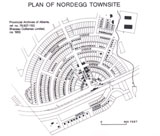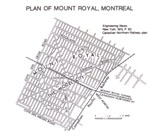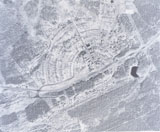Building Townsites: The Town of Nordegg and the Mount Royal Connection
These were the engineers who had just completed the plans for the model city of Mount Royal to be connected by a long tunnel to the centre of Montreal. The planners were guided by two main factors “...the convenience of its arrangement in respect to business, comfort and enjoyment of its inhabitants; and...its additional aspect in regard to [its] dignity and beauty.”3 These engineers were most likely aware of the garden city concept introduced in England by Ebenezer Howard and brought to Canada by Thomas Adams.4 Martin Nordegg must have known of this planning movement as he had travelled in England on business before coming to Canada.5 He was also aware of worker housing provided by industrialists in his native Germany. Nordegg was very solicitous of the workers' welfare and wanted to create a physically comfortable and aesthetically pleasing environment. Thus he had five- and four-room bungalows built, the former with bathrooms, but was persuaded not to install them in the latter.6 He wished to ameliorate the monotony of the architecture by painting the houses in different colours. “As the cottages all looked alike, except the five-room cottages, I wanted to show a variance of colour, and refusing the crude colors which the superintendant liked, I selected soft pastels which proved very pleasing to the eye. The selection was not easy, as clashes with the colour of the landscape had to be avoided.”7 Nordegg also made sure a fully equipped hospital was built.8
But Nordegg’s aesthetic and democratic attitudes were not always shared by others. The bathrooms were not appreciated by the residents and were removed, the added space being more acceptable.9 The untidiness of the miners also annoyed him and although he made strenuous efforts to educate the workers, their backyards continued to be unkempt.10 He was also disturbed when the decision was made to create an upper town across the tracks and up the slope for the higher officials, hospital staff and policemen. Not only did this create a physical barrier but also a psychological one, detrimental to the life of the community.11 Though Nordegg’s ideals were never fully realized, and he was forced to leave the mine and town in 1915, because of his alien status, he left content having achieved some part of his civilizing mission.
Notes | Bibliography | Abbreviations
1. M. Nordegg, The Possibilities of Canada are Truly Great: Memoirs 1906, 1907, edited with an introduction by T.D. Regehr (Toronto: Macmillan of Canada, 1971), p. 176.2. Ibid.
3. C. Price-Green, ed., “Canadian Northern Railway” Encyclopaedea (Toronto: n.p., 1918), p. 2.
4. J.F. Gilpin, “Nordegg, Alberta 1907–1955” (Edmonton: Unpublished Report, Alberta Culture, 1985), p. 13.
5. Nordegg, p. VII.
6. Ibid., pp. 176–77.
7. Ibid., p. 184.
8. Ibid., p. 177.
9. Ibid., p. 199.
10. Ibid.
11. Ibid., p. 196.


